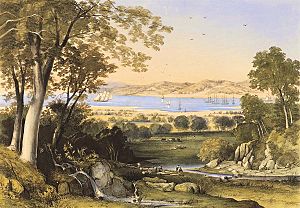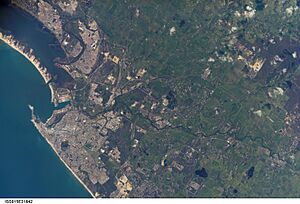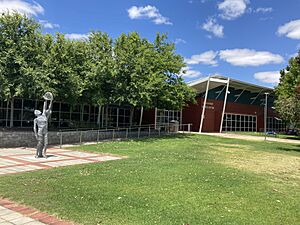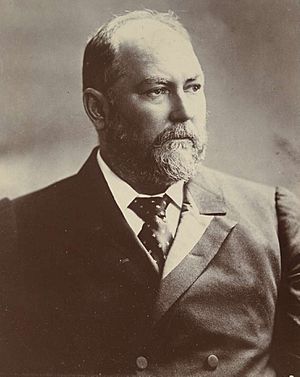Bunbury, Western Australia facts for kids
Quick facts for kids BunburyWestern Australia |
|
|---|---|

Panorama of Bunbury from lookout tower
|
|
| Population | 76,452 (2021) (24th) |
| • Density | 343.14/km2 (888.7/sq mi) |
| Established | 1836 |
| Elevation | 5 m (16 ft) |
| Area | 222.8 km2 (86.0 sq mi)(2021 urban) |
| Time zone | AWST (UTC+08:00) |
| Location |
|
| Region | South West |
| State electorate(s) |
|
| Federal Division(s) | Forrest |
Bunbury (also known as Nyungar: Goomburrup) is a city on the coast of Western Australia. It is about 175 kilometers (109 miles) south of Perth, the state capital. Bunbury is the third largest city in Western Australia. It has a population of about 75,000 people.
The city is located at the southern end of the Leschenault Estuary. Bunbury was started in 1836 by Governor James Stirling. It was named after Lieutenant Henry Bunbury. A port was built there soon after. This port became very important for the wider South West region. The city grew even more when the South Western Railway connected it to Perth in 1893.
The area called "Greater Bunbury" includes the City of Bunbury and three other local areas. These are the shires of Capel, Dardanup, and Harvey. This larger area stretches from Yarloop in the north to Boyanup in the south.
Contents
History of Bunbury
First People of Bunbury
The first people to live in the Greater Bunbury area were the Aboriginal Australian Noongar people. They hunted and fished in the area before Europeans arrived in the 1830s. The Noongar people called this place "Goomburrup."
Early European Settlement
The first European to see the Bunbury area was French explorer Captain Louis de Freycinet. He saw it from his ship in 1803. He named the area Port Leschenault. The bay on the western side of Bunbury was named Geographe.
In 1829, Dr Alexander Collie and Lieutenant Preston explored the land around Bunbury. In 1830, Governor Sir James Stirling visited the area. A military post was set up, but it only lasted six months. The Governor later renamed the area Bunbury. This was to honor Lieutenant Henry William St Pierre Bunbury, who found a difficult inland route to the area.
Bunbury's first settlers were John and Helen Scott and their family. They arrived in January 1838. The town was officially mentioned in 1839. Land lots were surveyed in 1841 and opened for people to choose.
From the 1830s to the 1850s, people sometimes hunted whales along the coast. By 1842, Bunbury had 16 buildings, including an inn. A growing port helped the settlers and local businesses.
The timber industry became very important for Bunbury's port. Large timber logs were floated down the Collie River. They were then loaded onto ships. These ships took the timber to other parts of the world. The strong hardwood timbers were used for things like railway sleepers.
In 1884, the government decided to build a railway from Bunbury to Boyanup. This line was 16 miles (26 km) long. It was finished in 1887. At first, horses pulled the trains. In 1891, the government took over the line and used locomotives.
Because this railway was separate from the capital, people wanted a connection. In 1893, the South Western Railway was built. This connected Bunbury to Perth. The Boyanup line was also extended to Donnybrook that same year. These railways helped connect Bunbury's port to coal, minerals, and farms.
By 1898, the town's population was 2,970 people. In 1903, a breakwater was finished. This helped protect the bay and port area even more.
Modern Bunbury
The Old Bunbury railway station was the end point for the Australind passenger train from Perth. The first passengers used it on November 24, 1947. The last train left this station on May 28, 1985. A new station opened in East Bunbury the next day. This new station was about 4 kilometers (2.5 miles) to the south-east.
In 1976, there was an event at Bunbury's export port terminal. This event caused damage to the port. It was done by environmental groups who wanted to stop the woodchipping industry. The damage to the port was about $300,000. Windows in nearby houses were broken, and the sound was heard far away. No one was hurt during this event.
Geography of Bunbury
Bunbury is about 175 kilometers (109 miles) south of Perth. It is located where the Preston River and Collie River meet. These rivers flow into the southern end of the Leschenault Inlet. This inlet then opens into Koombana Bay and the larger Geographe Bay. Geographe Bay stretches south towards Cape Naturaliste.
Climate of Bunbury
Bunbury has a Mediterranean climate. This means it has warm to hot, dry summers. It also has cool, wet winters. Most of the rain falls from May to September.
| Climate data for Bunbury, Western Australia (1995–2022) | |||||||||||||
|---|---|---|---|---|---|---|---|---|---|---|---|---|---|
| Month | Jan | Feb | Mar | Apr | May | Jun | Jul | Aug | Sep | Oct | Nov | Dec | Year |
| Record high °C (°F) | 40.8 (105.4) |
40.0 (104.0) |
39.5 (103.1) |
34.6 (94.3) |
29.2 (84.6) |
24.2 (75.6) |
22.4 (72.3) |
24.6 (76.3) |
30.4 (86.7) |
32.9 (91.2) |
36.0 (96.8) |
39.2 (102.6) |
40.8 (105.4) |
| Mean daily maximum °C (°F) | 29.9 (85.8) |
30.0 (86.0) |
27.7 (81.9) |
24.2 (75.6) |
21.0 (69.8) |
18.5 (65.3) |
17.3 (63.1) |
17.7 (63.9) |
18.6 (65.5) |
21.1 (70.0) |
24.4 (75.9) |
27.5 (81.5) |
23.2 (73.8) |
| Mean daily minimum °C (°F) | 15.4 (59.7) |
15.9 (60.6) |
14.4 (57.9) |
11.8 (53.2) |
9.2 (48.6) |
8.1 (46.6) |
7.3 (45.1) |
7.6 (45.7) |
8.5 (47.3) |
9.7 (49.5) |
12.1 (53.8) |
13.6 (56.5) |
11.1 (52.0) |
| Record low °C (°F) | 5.3 (41.5) |
6.0 (42.8) |
2.2 (36.0) |
2.4 (36.3) |
−0.1 (31.8) |
−3.0 (26.6) |
−2.1 (28.2) |
0.0 (32.0) |
−0.3 (31.5) |
0.2 (32.4) |
2.1 (35.8) |
3.2 (37.8) |
−3.0 (26.6) |
| Average precipitation mm (inches) | 10.8 (0.43) |
8.8 (0.35) |
19.9 (0.78) |
38.4 (1.51) |
99.5 (3.92) |
134.5 (5.30) |
145.5 (5.73) |
118.2 (4.65) |
80.1 (3.15) |
36.7 (1.44) |
21.5 (0.85) |
16.3 (0.64) |
728.6 (28.69) |
| Average precipitation days | 1.4 | 1.1 | 2.5 | 5.3 | 9.1 | 13 | 15.1 | 13.8 | 11.5 | 6 | 3.3 | 1.9 | 84 |
| Average afternoon relative humidity (%) (at 15:00) | 44 | 43 | 46 | 55 | 59 | 64 | 65 | 66 | 64 | 58 | 52 | 48 | 55 |
| Average dew point °C (°F) | 13.1 (55.6) |
13.3 (55.9) |
12.4 (54.3) |
12.2 (54.0) |
11.1 (52.0) |
10.0 (50.0) |
9.2 (48.6) |
9.5 (49.1) |
9.7 (49.5) |
10.5 (50.9) |
11.5 (52.7) |
12.2 (54.0) |
11.2 (52.2) |
| Source: Bureau of Meteorology | |||||||||||||
People of Bunbury
Population Growth
In 2007, Bunbury was named Australia's fastest growing city. This was for the period of 2005 to 2006.
At the 2021 census, Bunbury's city population was 76,452. The average age of people was 39. Experts believe that by 2031, the population of the Greater Bunbury area will be over 100,000.
Backgrounds and Languages
In 2021, 74.8% of people in Bunbury were born in Australia. The next most common birthplaces were England (5.5%) and New Zealand (3.0%). Most people (85.7%) spoke only English at home. Other languages spoken included Afrikaans and Mandarin.
Religion and Jobs
In the 2021 Census, many people (47.5%) said they had no religion. The most common religions were Catholic (17.2%) and Anglican (12.3%).
The most common jobs in Bunbury were Technicians and Trades Workers (18.4%). Other common jobs included Professionals and Labourers. In 2021, the unemployment rate in Bunbury was 4.9%.
How Bunbury is Governed
The Greater Bunbury area includes four local government areas. These are the City of Bunbury, Shire of Capel, Shire of Dardanup, and Shire of Harvey. The Greater Bunbury Region Scheme helps plan how land is used in this area. It has been in place since November 2007.
State and local governments manage the Greater Bunbury area. There isn't one single government for the whole sub-region.
In 2013, the Western Australian Planning Commission released the Greater Bunbury Strategy. This plan guides how land is used for cities, industries, and regions. It also helps with building new infrastructure. The plan aims for Bunbury to grow to 150,000 people beyond 2050. This will happen by building more in existing areas and developing new land.
Bunbury's Economy
Bunbury has a varied economy. This means it has many different types of businesses and jobs. These include heavy and general industries, mining, and farming. It also has many services for its growing population. Important transport links and the influence of Perth also play a role.
The mining and mineral processing sector is the biggest part of Bunbury's economy. It brings in $2 billion each year. Farming is also very important. It produces about $146 million worth of goods each year. This is about 30% of all farming in the South West region.
Other important industries in Greater Bunbury include:
- Retail and service industries (shops and services)
- Building industry
- Timber production
- Tourism
Bunbury is home to SIMCOA. This is Australia's only company that makes silicon. The Bunbury Port will continue to be a main center for business. Goods flow through it to and from all over the world. Plans to make the port bigger will help the economy grow even more. This could also bring more businesses to Bunbury city center.
Education in Bunbury
In Western Australia, school is required for children aged six to seventeen. This includes primary and secondary school.
High schools in the Bunbury area include:
- Bunbury Senior High School
- Newton Moore Senior High School
- Manea Senior College
- College Row School (for students needing extra support)
- Australind Senior High School
- Eaton Community College
- Dalyellup College
- Bunbury Cathedral Grammar School (for all ages, K-12)
- Bunbury Catholic College
- Grace Christian School
- Our Lady of Mercy College
Higher Education
After high school, students can go to universities or technical and further education (TAFE) colleges. South Regional TAFE offers many vocational courses. It has campuses in Bunbury, Albany, and other places in southern Western Australia.
Edith Cowan University also has a campus located in Bunbury.
Media in Bunbury
Radio Stations
Bunbury has many radio stations on both AM and FM bands. They offer different types of programs:
- AM band:
- SEN Spirit 621 Southwest (Sports, Talk, Music)
- ABC South West WA (News, Talk, Sport)
- Triple M (Adult Contemporary music, local news)
- Vision Radio Network (Christian music and talk)
- 6MM (Easy listening from Mandurah)
- ABC Radio National (Specialty talk and music)
- ABC News Radio (News and sport)
- FM band:
- 6MM (The Wave) (Easy listening from Mandurah)
- ABC Classic FM (Classical music)
- Triple J (Alternative music)
- Hit FM (Hit music)
- Bunbury Community Radio
- Harvey Community Radio
- Coast FM (Hit music from Mandurah)
Television Channels
You can watch several TV services in Bunbury:
- The Australian Broadcasting Corporation (ABC)
- The Special Broadcasting Service (SBS)
- Seven (local news from GWN7)
- WIN Television (shows Nine Network programs)
- West Digital Television (shows Network 10 programs)
These channels mostly show the same programs as in Perth. But they have some local news, sports, and other shows. Seven's studios are in Bunbury. They make a nightly news program for regional Western Australia.
New digital TV channels started in Bunbury on July 28, 2011. These include channels like 7two, 7mate, 10 HD, 9Gem, and 9Life.
You can also get Foxtel, a pay TV service, through satellite.
Newspapers
Local newspapers in Bunbury include:
- Bunbury Herald
- South Western Times
- Bunbury Mail
Newspapers from Perth, like The West Australian and The Sunday Times, are also available. National newspapers like The Australian can also be found.
Culture and Fun in Bunbury
Arts and Entertainment
Bunbury has several places for arts and culture:
- Bunbury Regional Art Galleries
- Bunbury Regional Entertainment Centre (for theatre, movies, and live shows)
- Stirling Street Arts Centre
The Bunbury Historical Society is in King Cottage. This old house was built around 1880. It shows how a family lived in Bunbury from the 1880s to the 1920s.
The WA Performing Arts Eisteddfod is held every year at the Bunbury Regional Entertainment Centre. This is a competition for performing arts.
Tourism and Recreation
Bunbury offers many fun things to do and places to visit:
- Dolphin Discovery Centre
- Bunbury Back Beach
- Koombana Bay
- Bunbury Wildlife Park
- Bunbury Farmers Market
- Leschenault Inlet
Bunbury is also very close to the beautiful Ferguson Valley.
Sports
Several Australian rules football clubs are in Bunbury. They play in the South West Football League. A well-known stadium is Hands Oval in South Bunbury.
Hay Park Sports Precinct is a big area for many junior and senior sports. The South West Sports Centre is located there. It is home to the Bunbury Basketball Association.
Bunbury has three clubs in the South West Soccer Association:
- Bunbury Dynamos
- Bunbury United
- Hay Park United
Bunbury's Infrastructure
Transport Links
Bunbury Airport serves the Greater Bunbury area. It is about 8 kilometers (5 miles) southeast of the city center.
TransWA provides train and bus services from Bunbury Terminal. The Australind train goes to Perth. Other bus services go south from Bunbury. South West Coach Lines also offers bus services. TransBunbury runs 10 bus routes within Greater Bunbury.
National Route 1 provides road access to the wider region. This includes:
- Forrest Highway, a dual carriageway road going north to Perth.
- South Western Highway going to the southeast of Bunbury.
Bussell Highway connects Bunbury to Busselton in the west.
The Eelup Rotary, where Forrest Highway ends, was once a very busy intersection. It has been upgraded with traffic lights and extra lanes.
Bunbury was bypassed by the new Wilman Wadandi Highway in 2024. This highway connects Forrest Highway to Bussell Highway.
Famous People from Bunbury
Many well-known people have come from or lived in Bunbury. Here are a few:
- Natalie Barr, a host on the TV show Sunrise.
- Dianne Buswell, a professional dancer on Strictly Come Dancing.
- Courtney Eaton, an actress who was in Mad Max: Fury Road.
- John Forrest, an explorer and the first Premier of Western Australia.
- Alexandra Hagan, an Olympic rower.
- Newton Moore, a former Mayor of Bunbury and Premier of Western Australia.
- John Boyle O'Reilly, an Irish poet who was a convict in Bunbury and later escaped.
- Josh Risdon, a soccer player for the Australia national team.
- Nicole Trunfio, a model.
See also
 In Spanish: Bunbury (Australia Occidental) para niños
In Spanish: Bunbury (Australia Occidental) para niños






